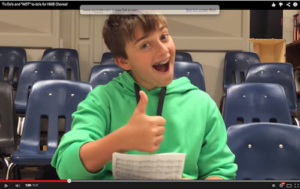This is part 4 of the series “Why Won’t My Middle School Choir Sing?”
Click here to see the first post in the series!
Reason #4:
We focus too much on technique and not enough on developing their true artistry.
In my 24 years of teaching this age group, I’ve seen lots of middle school choirs who sing proficiently. By that, I mean, it is evident the teacher taught diction, phrasing, dynamics, etc.
…the basics.
Most of us spend a lot of time on the technical side of music because our middle school beginners NEED it!
However, we can suck the oxygen out of our singers if we relentlessly seek technical perfection.
Working toward it nonstop can become boring to them really quickly.
Why do people love watching Cirque de Soleil?
It’s not just the incredible athleticism that is displayed which took countless hours of training and technical work to develop. It’s the unforgettable way our spirits are moved when the athleticism is combined so beautifully with music and lighting and costuming.
If we want athleticism alone, we can simply watch track and field or men’s gymnastics.
In our middle school classrooms, we have to inject more “Cirque de Soleil”.
When I watch the choirs of teachers who have focused entirely on technique, it feels like eating cake that has no butter and sugar.
To quote the famous movie “Sixth Sense”… When I see and hear a technically proficient performance in which it is clear the students are well trained but have no idea about what they are singing, “I see dead people.”
I feel nothing.
The performance is utterly unmoving.
That is not what music is.
Teachers often ask, “How do I get them to who facial expression? Raise their eyebrows? Smile?”
My answer: From the inside out.
Here is how you DON’T do it.
Don’t say “Raise your eyebrows! Smile! Sing with facial expression”. With this age group, it doesn’t work.
Regardless of the obscurity of the meaning of the song and how it seems to have absolutely no meaning to them in their young lives, we must find a way to help them emotionally connect to a song. Just talking about the meaning of the song or giving historical context will NOT do it.
We have to be willing to make them think. We have to help them connect the dots to their own lives in some way.
As part of our teaching priorities, we have to indicate to our singers the importance of singing honestly and serving the music.
I tell my own students that, as choir singers, they are also actors. Actors must put their personal stuff aside and act the part.
Then, we, the teachers, must guide them through the treasure trove of their life experiences to find a meaning that they can sing for that particular song. Believe it or not, they notice the fact that WE value their own life experiences enough to ask them to inject them and use them as they sing because, so often in their young lives, their pain and their life experiences are dismissed.
When I’m teaching “Sleigh Bells”, and they are singing with absolutely no energy at all because it is a Wednesday and not a Friday and they are hating school and their boyfriends just broke up with them and they have two projects due….blah, blah, blah…I stop the music, and I say: “Do you like snow days?” They usually scream “YES!” Then, I say, “Pretend that you just found out tomorrow is a snow day and then sing it!”
It changes everything.
When I am able to successfully take them to some sort of internal emotional moment to which they can relate for a particular song, everything changes. Many of the technical issues we’ve labored over correct themselves. They breathe bigger. They sing with truth. Their faces come to life. Their tone has energy.
The results must come from inside their hearts. When you are able to help them find it and deliver it in a performance, the energy of the audience is palpable as they receive this truly artistic moment.
…you will get goose bumps…
…and so will your students.
Sharing a “goose bump moment” has major positive impacts on your program. It’s worth the work to help them get to that emotional place in rehearsal and then to deliver it in performance.
Honestly…I enjoy that part the most!
Click here to go to my YouTube Channel and see “To Do’s and NOT to Do’s of Middle School Chorus!”

To learn more about Mr D’s S-Cubed Middle School Sight Singing Program, click here!
Click here to purchase the S-Cubed Middle School Sight Singing Bundle.
Dale

+(1).gif)


So true, so inspiring to be reminded
Great post – great reminders before the start of the new year! Thanks Dale.